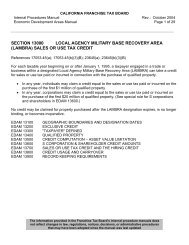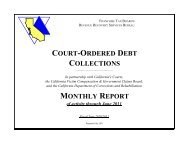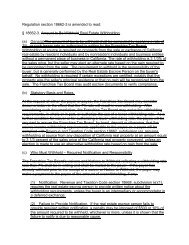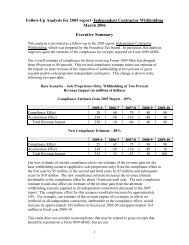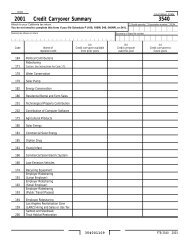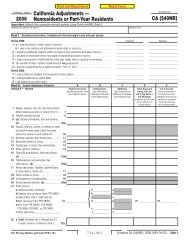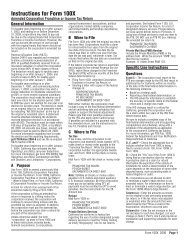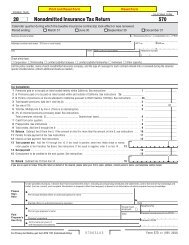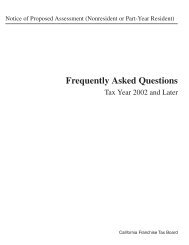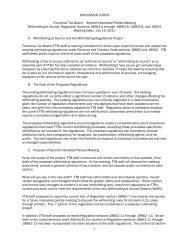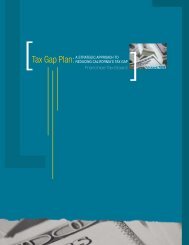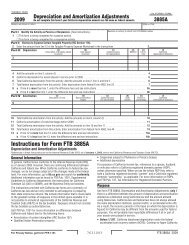E-Government Blueprint Text Only Document - California Franchise ...
E-Government Blueprint Text Only Document - California Franchise ...
E-Government Blueprint Text Only Document - California Franchise ...
Create successful ePaper yourself
Turn your PDF publications into a flip-book with our unique Google optimized e-Paper software.
Members of the Board<br />
Kathleen Connell, Chair<br />
Dean Andal, Member<br />
B. Timothy Gage, Member<br />
E- E-<strong>Government</strong><br />
E- <strong>Government</strong><br />
<strong>Blueprint</strong>*<br />
<strong>California</strong> <strong>Franchise</strong> Tax Board<br />
<strong>California</strong> <strong>Franchise</strong> Tax Board’s vision,<br />
goals & strategies for transforming the<br />
relationship with customers through<br />
electronic commerce opportunities<br />
E-<strong>Government</strong> <strong>Blueprint</strong> <strong>California</strong> <strong>Franchise</strong> Tax Board<br />
September 2000<br />
* This is the “text-only” version of the <strong>Blueprint</strong> for easy downloading. For the complete <strong>Blueprint</strong>, please visit our<br />
website at www.ftb.ca.gov
Contents<br />
Contents<br />
Introduction: A Time for Transformation…………………………..…………..………….…..………..1<br />
FTB’s E-<strong>Government</strong> Vision, Goals & Objectives………………..…………..…………..……......……4<br />
Strategies for Success.……………………………………………..…………..…………..…...………10<br />
E-Architecture Plan…………………………………………..………..…………..…………………….12<br />
Conclusion………………………………………………………..…………..………………..…..…….15<br />
E-<strong>Government</strong> <strong>Blueprint</strong> <strong>California</strong> <strong>Franchise</strong> Tax Board
Introduction<br />
A Time for Transformation<br />
The <strong>California</strong> <strong>Franchise</strong> Tax Board has been using technology to improve the way it does business with the<br />
public for years, but now the department is poised to transform how it interacts with its customers. The goal is<br />
electronic government, or e-government, which is a new model for how government interacts with citizens and<br />
other business partners in the private and public sectors. For FTB, the goal of e-government is to provide taxpayers,<br />
businesses, and our other business partners integrated electronic services that are relevant, convenient, and<br />
secure—and delivered in Internet time. This also means an internal, organizational transformation that supports<br />
the new business model. New technology is the medium facilitating the move to e-government, but there are<br />
other factors driving the need for change to happen now rather than later:<br />
Customer Service Demands: Our customers—whether individual taxpayers, businesses, or third<br />
parties and suppliers—now expect electronic/Internet options for interacting with FTB similar to those options<br />
they have come to rely on when transacting business with the private sector. FTB has embraced e-government<br />
as an opportunity to explore new business models that deliver real value to our customers and other<br />
business partners.<br />
E-<strong>Government</strong> Initiatives: Leaders in federal, state, and local government are responding to citizen<br />
demands for electronic services by formulating e-government initiatives. We anticipate that these initiatives<br />
will soon mandate that all government agencies provide electronic service options accessible to the public<br />
through common portals.<br />
Global Competition: <strong>California</strong> government recognizes that the continued economic growth and<br />
prosperity of the state is dependent upon its ability to make doing business with FTB and all state agencies<br />
fast and easy for the customer—whether an individual or a multi-national corporation—and efficient for the<br />
agency. A government agency with the appropriate e-government infrastructure and capabilities will be an<br />
agency that can play a role in keeping <strong>California</strong> competitive in the global marketplace.<br />
In short, e-government is inevitable, and it is the right thing to do; this is not a choice—this is our charge. This is<br />
also our challenge, and we realize that FTB’s e-government initiative is not simply a new project or application. It<br />
is a fundamental change in how we view our relationship and interaction with individual taxpayers, businesses<br />
and our other partners. Most of all, e-government is customer-centric, putting the customer first by designing<br />
business solutions and services that are tailored, accessible, and preserve public trust.<br />
E-<strong>Government</strong> <strong>Blueprint</strong> <strong>California</strong> <strong>Franchise</strong> Tax Board<br />
1.
Past successes at FTB have paved the way<br />
for this transformation<br />
We have been providing convenient electronic services to customers since 1993 when FTB implemented<br />
the Electronic Funds Transfer (EFT) program. But EFT was only the first in a host of other e-services that<br />
have since been rolled out, including Electronic Filing of tax returns (1994), establishing an FTB website<br />
on the Internet (1995), TeleFiling (1996), Internet-based Online Tax Filing (1998), and “e-pay,” which allows<br />
e-filers and TeleFilers to authorize FTB to debit their bank accounts for a balance due (1999).<br />
2,500,000<br />
2,000,000<br />
1,500,000<br />
1,000,000<br />
500,000<br />
Millions<br />
0<br />
E-Filing Growth<br />
1997 1998 1999 2000<br />
E-payment/E-Refund Growth (# of transactions)<br />
2000<br />
1999<br />
1998<br />
25<br />
20<br />
15<br />
10<br />
5<br />
0<br />
0 500,000 1,000,000 1,500,000<br />
FTB Website Use<br />
1997 1998 1999 2000(est.)<br />
E-File Practitioners<br />
E-File Taxpayers<br />
TeleFile<br />
Direct Deposit of<br />
Refund<br />
EFT/e-pay/credit<br />
card<br />
Website Visits<br />
Forms Downloaded<br />
E-<strong>Government</strong> <strong>Blueprint</strong> <strong>California</strong> <strong>Franchise</strong> Tax Board<br />
2.
The New World of E-<strong>Government</strong><br />
All of these electronic services achieve the goal of making customer services convenient for the customer and<br />
efficient for FTB. But the future direction of these services—thanks to technological innovations and growing<br />
public use of the Internet—will move FTB and other government agencies into a new world, the world of egovernment.<br />
E-government means using expertise, technology, and partnerships to integrate government services for the<br />
public. Until recently, <strong>Government</strong>, in general, has approached the task of providing services from an agencycentric<br />
perspective. But e-government views the world from a customer-centric perspective, a paradigm that<br />
precludes stovepipe services in which citizens must go to multiple agencies (and often multiple offices within an<br />
agency) to do business with government. Providing services from a customer-centric perspective means developing<br />
a single service interface regardless of what agency actually provides the service. The only “agency”<br />
becomes “<strong>California</strong>” which is accessed by customers through a single Internet portal. In short, the boundaries of<br />
government agencies begin to blend as <strong>California</strong> begins to build an integrated <strong>Government</strong>.<br />
Within FTB, this blending occurs as an integration of services based on a shared information technology infrastructure.<br />
In simpler terms, customers will access our services—whatever the nature of the service—through a<br />
single Internet portal. Their needs will then be met through an intentions-based menu of options. No longer<br />
would customers need to decipher bureaucratic terms to decide where they need to navigate to transact business<br />
with FTB. The term “user friendly” does not do justice to the extent of this streamlining of our processes to meet<br />
public needs. Ultimately, the technology will allow us to provide individualized customer service—customized<br />
interactions with taxpayers.<br />
While we focus our organizational attention on external service to our customers and their agents, we will also be<br />
laying the groundwork for internal transformation—how we conduct business internally and with our suppliers.<br />
This internal transformation further supports our goal of external transformation by making sure FTB staff has the<br />
information and the tools necessary to provide excellent customer service. For our employees, this also means<br />
having online access to their own personnel information, and working in an organization with integrated administrative<br />
processes. Through an enterprise-wide approach, FTB will integrate and, where appropriate, automate<br />
processes that include budget and procurement transactions, personnel transactions, and workflow processes.<br />
This transformation will be no simple matter. It requires a bold vision and goals that stretch our organizational<br />
capacity to meet the changing needs of <strong>California</strong> and all of our customers.<br />
E-<strong>Government</strong> <strong>Blueprint</strong> <strong>California</strong> <strong>Franchise</strong> Tax Board<br />
3.
FTB’s E-<strong>Government</strong> Vision<br />
Consistent with the department’s strategic goals and its history of providing convenient electronic services since<br />
1993, the following vision statement sets FTB’s strategic e-government direction for 2000 – 2005:<br />
Transform the relationship between FTB and our customers, suppliers and distribution channels<br />
by using appropriate technologies to offer high-quality e-government services.<br />
FTB will become more accessible to taxpayers and others by offering an array of products and services that are<br />
easy to use, tailored, secure, confidential and convenient. These electronic channels will create value for our<br />
customers without increasing cost or burden and without increasing long-term costs to FTB.<br />
Goals & Objectives<br />
FTB’s e-government vision will be achieved by pursuing two defined goals with specific objectives. The first goal<br />
is focused externally on our interaction with the customer, and the second goal focuses on our internal business<br />
processes.<br />
Goal 1:<br />
Deliver E-<strong>Government</strong> Services to our Customers and Their Agents. Make it easier for <strong>California</strong>ns to<br />
comply with the tax laws and do business with FTB by offering them the ability to conduct all their interactions with<br />
FTB electronically, using methods that are secure, convenient, and tailored to their needs.<br />
Objectives:<br />
Provide all external FTB forms and publications to our customers online. For the past few years,<br />
FTB has provided web access to and downloading options for most popular tax forms. We need to<br />
expand this access for all forms. In today’s environment, this is an absolutely essential and immediate<br />
step that we must take to serve those customers who prefer getting their information online. Making all<br />
our forms and publications available to download will give our customers a convenient and easy option for<br />
getting this information quickly.<br />
Present a customer-centric online view of FTB. Making general tax information available online is<br />
good, but putting it online in a manner that makes intuitive sense to our customers and meets the specific<br />
needs of different customer segments is even better. Not only will we endeavor to make our own internal<br />
boundaries transparent to our customers, but we will work with other organizations to make it increasingly<br />
easy for our customers to get all of the information they need with the fewest clicks of their mouse.<br />
Provide options for customers to communicate with FTB online. Offering online communication<br />
options to our customers will make it easier and more convenient for them to get the information and<br />
assistance they need. By ensuring the security of those online communications, we can exchange the<br />
confidential information needed to get our customers the right answers to their questions and resolve any<br />
problems they might be having as quickly as possible.<br />
Offer online self-service options for customer transactions. Our customers will be able to go online to<br />
file various types of returns, make payments, track the progress of their refunds, access their personal<br />
account information, set up payment arrangements, appeal an action that we have taken, and more. Offering<br />
transactions online, in a secure environment, 24 hours-a-day, 7 days-a-week, will help make doing business<br />
with FTB as simple, easy, and convenient as possible and put more of the control over transactions into the<br />
hands of our customers. As appropriate, FTB will pursue partnership opportunities with tax practitioners, the<br />
electronic tax services industry and others to enable a variety of self-service options.<br />
E-<strong>Government</strong> <strong>Blueprint</strong> <strong>California</strong> <strong>Franchise</strong> Tax Board<br />
4.
Goal 2:<br />
Send customized online information to taxpayers. Every customer has unique needs and preferences.<br />
That’s why each customer should be able to select both the types of information they want online<br />
and their method of obtaining it. Some may want to be reminded when a deadline is looming or prefer to<br />
have FTB assemble information and send it to them. Others may prefer to do it themselves. Whatever<br />
their preference, FTB will try to find a way to meet it. Representatives of taxpayers also will be included in<br />
the scope of this objective, to ensure that these intermediaries can continue to provide value-added<br />
services to their clients.<br />
Use Appropriate Technologies to Improve How We Conduct Business Internally and with Our Suppliers.<br />
Re-think and re-engineer how we do business in order to increase efficiency and mirror best practices.<br />
Objectives:<br />
Provide all internal forms, publications and manuals online. A majority of internal forms already are<br />
accessible via FTB’s internal network. But many more will be added along with more detailed publications<br />
and manuals. Ready access to the information that we need to do our jobs will help us serve our<br />
customers better and improve our efficiency and effectiveness. By making internal information and forms<br />
available to our employees online, they’ll be able to get information when they need it, wherever they<br />
are—whether conducting an audit in our Manhattan office, collecting on an account in Los Angeles, or on<br />
the phone with a taxpayer in Sacramento.<br />
Present an employee-centric online view of internal FTB information for inquiry by FTB users. It<br />
should be as simple as possible for our employees to quickly find the information they need to do their<br />
jobs well. That means offering online information in a manner that gets them to the information they need<br />
(e.g., budgets, collections, or personnel), with just a few clicks of their mouse, regardless of where it<br />
resides in the organization. One important element included in this objective involves the implementation<br />
of new functionality to match specific information to a specific employee according to the job duties of<br />
that employee.<br />
Conduct our administrative business processes electronically, including transactions with external<br />
suppliers. To offer our customers the ability to do business with us online, we must also develop the<br />
capacity to conduct our own internal processes electronically. As a government agency, we believe that<br />
we owe it to taxpayers to operate as efficiently as possible.<br />
Develop an integrated, online view of job-related taxpayer information (i.e., “taxpayer folder”). By<br />
making all of the electronic information relevant to a particular taxpayer issue available to our employees<br />
in a virtual “taxpayer folder”, they will be able to resolve issues more quickly and more accurately.<br />
Whether responding to an e-mail, conducting an audit, or setting up a payment arrangement, FTB employees<br />
will have all of the information they need to get the job done right the first time. One important<br />
element included in this objective involves the analysis of how information from a variety of technology<br />
systems can be presented at the desktop level to employees.<br />
E-<strong>Government</strong> <strong>Blueprint</strong> <strong>California</strong> <strong>Franchise</strong> Tax Board<br />
5.
Implement foundational architecture for an e-employee database to provide the core database for future<br />
development and integration of departmental administrative systems<br />
Implement an integrated, enterprise-wide approach for on-line training nominations, approvals and<br />
funding<br />
Long Range Plans and Stakeholder Involvement<br />
As these and other initial projects are being implemented, FTB will also be developing and implementing the first<br />
phases of some of the more complex business solutions that are required for the e-government transformation. A<br />
more detailed implementation plan is under development by FTB to describe these longer-range projects, including<br />
the benefits for taxpayers as well as operational efficiencies. During the next few months, FTB will solicit<br />
stakeholder and customer input as part of the process to define specific e-government initiatives beyond the 2000<br />
– 2002 period. FTB anticipates that the initial iteration of this long-range plan will be available in the fall of 2000.<br />
To keep our customers and business partners aware of our progress and to provide them with the specific details<br />
of FTB efforts, tactical plans and implementation reports and updates will be provided on FTB’s website. We<br />
anticipate that response to these reports and updates, in addition to our ongoing collection of stakeholder data<br />
regarding desired services, will ultimately lead to the customer-centric services desired by the public and our<br />
business partners.<br />
E-<strong>Government</strong> <strong>Blueprint</strong> <strong>California</strong> <strong>Franchise</strong> Tax Board<br />
7.
Strategies for Success<br />
We recognize that the issues surrounding e-government are broad and complex. It is not simply a matter of<br />
publishing existing information on a website. Consequently, we are focusing on four critical areas in the initial<br />
phase of our initiative: ensuring public trust by protecting taxpayer privacy and maintaining data security; expanding<br />
partnerships with the public and private sector; focusing on customer needs and expectations; and assessing<br />
our organizational capacity to ensure our own e-organizational readiness for the future.<br />
Strategy #1: Ensure Public Trust<br />
E-government in any form can only succeed with the public’s trust in the services offered. This is especially true<br />
when it comes to one of the critical components of e-government interaction from the citizens’ perspective—the<br />
filing and paying of taxes.<br />
Taxpayer Privacy: At the top of the list of concerns for any citizen, whether interacting with an online retailer or a<br />
government organization, is privacy. How will FTB use taxpayer information once it is sent to us online? In one<br />
word—responsibly. We recognize that when citizens send personal information such as financial data, or name<br />
and address information, they are entrusting us with information that demands the highest safeguards against<br />
inappropriate use. FTB plans to take the following steps to ensure taxpayer privacy:<br />
• Implement all e-government services consistent with FTB’s privacy principles and policies and, furthermore,<br />
require our contractors to safeguard the confidentiality of taxpayer information with equal diligence in adherence<br />
to privacy polices.<br />
• Educate taxpayers and third parties involved in tax preparation regarding best practices for protecting the<br />
privacy of tax information.<br />
• Recognize how FTB policies impact third party use of taxpayer information and establish polices that will<br />
safeguard taxpayer privacy.<br />
• Explore means to limit third party marketing using name and address information of taxpayers who file online.<br />
Additionally, FTB will communicate its privacy policy through our portal and other means in order to build public<br />
trust and encourage use of e-services. We want the public to know that their information is safe, but also understand<br />
what it is we do to deserve their trust to protect their privacy.<br />
Security: Data sent to FTB will be carefully protected from interception, and the networks through which data is<br />
processed and the databases where the data is stored will be secure. FTB already has a well-deserved reputation<br />
for secure data transmission and networks, and we will continue to maintain superior, secure services through<br />
strategies that include the following:<br />
• Use industry standards for data security at all levels, from the firewalls to the desktops, including the use of<br />
strong 128-bit SSL encryption and ongoing monitoring of all Internet connections and servers for intrusion<br />
detection.<br />
• Ensure transaction integrity so that information is not subject to interception or tampering during transmission.<br />
• Ensure appropriate use of information by FTB employees in an environment where more information will be<br />
available than ever before.<br />
• Develop policies and implement security measures consistent with statewide efforts.<br />
Authentication: For any FTB e-government application we develop, a corresponding authentication model will<br />
be used. FTB plans to use the two widely accepted authentication methods: Public Key Infrastructure (PKI) and<br />
E-<strong>Government</strong> <strong>Blueprint</strong> <strong>California</strong> <strong>Franchise</strong> Tax Board<br />
8.
challenge response, which uses PINs or passwords. The latter is the common industry standard for e-commerce<br />
transactions, but FTB will use PKI for applications requiring a higher level of security. PKI uses Digital Certificate<br />
technology, and we will outsource the issuance of certificates to a <strong>California</strong> registered Certificate Authority.<br />
Authentication strategies include the following:<br />
• Employ the level of authentication appropriate for the particular type of transaction.<br />
• Ensure nonrepudiation by developing authentication methods that ensure that an individual or organization<br />
cannot disavow certain transactions after they have taken place.<br />
• Adopt common authentication policies and practices across the department and support adoption of common<br />
policies and practices at the state level.<br />
Strategy #2: Expand Partnerships<br />
Just as e-commerce breaks down the barriers between stovepipe or segregated business lines and services<br />
within organizations, e-government dissolves the old boundaries between diverse groups in the public and private<br />
sector. A government agency can no longer remain an island, cut off from the mainland. To fully leverage the<br />
opportunities to serve the public and become more efficient, a government agency must partner with the private<br />
sector and other government service providers. These new partnerships also require new business models for<br />
FTB and other government entities.<br />
Relationship with Private Sector: FTB has had many successful and mutually beneficial partnerships with<br />
technology solution contractors and various groups of the tax practitioner community. But in the wired world of egovernment<br />
and e-commerce, the roles for all players are changing, and new relationships need to be forged.<br />
For us, it is especially important that we have increased collaboration and communication with tax practitioner<br />
groups and tax software developers and vendors. We understand that bridging the gap between the public and<br />
private sector is in the best interest of the taxpayers, and that without these partnerships, services will be less<br />
than optimal. We will use the following strategies to expand our relationships with the private sector:<br />
• Recognize that government/private sector roles are changing, and respond to the new opportunities resulting<br />
from this transition.<br />
• Pursue partnerships with private sector as a means of adding value for customers and leveraging government<br />
resources.<br />
• Explore new business models that provide new economic value.<br />
• Safeguard the relationship between government and its citizens.<br />
• Strive to meet the needs of all taxpayers, including those who prefer to deal directly with government.<br />
• Publish and support open data sharing standards.<br />
Partnerships with Other <strong>Government</strong> Organizations: Equally important in this period of changing roles is the<br />
blending of the roles of government from the citizen perspective. Citizens do not care what agency provides them<br />
service so long as the service is accessible, convenient and tailored to meet their needs. This can only happen if<br />
separate government agencies are willing to cooperate and partner with one another to provide the public a single<br />
interface. We will pursue this transition through the following strategies:<br />
• Recognize that e-government provides opportunities to reevaluate how government organizations jointly<br />
serve our citizens.<br />
• Pursue partnerships with other state and federal organizations in order to deliver customer-centric products<br />
and services and leverage government resources.<br />
• Explore new business models that add value for our customers and increase government efficiency.<br />
E-<strong>Government</strong> <strong>Blueprint</strong> <strong>California</strong> <strong>Franchise</strong> Tax Board<br />
9.
Statewide Alignment: As FTB explores its own e-government opportunities, the state of <strong>California</strong> is also addressing<br />
the issue through a statewide effort. We will encourage and support statewide e-government efforts and<br />
ensure consistency of FTB initiatives with the state e-government framework. FTB will also partner with other<br />
state government organizations in order to offer information and services from a customer-centric point of view<br />
without regard to organizational boundaries.<br />
Strategy #3: Become Customer-Centric<br />
Central to the e-government initiative is the need for all decisions to be made from the perspective of our customers—individuals,<br />
businesses, and all of our business partners. FTB has always been a customer-focused organization,<br />
but now we will make the critical transition to becoming a customer-centric organization. We will succeed<br />
in this approach by ensuring that we gain stakeholder input, that we address issues that include the “digital<br />
divide,” and that we remain customer-focused when we develop service delivery systems. Also, we will ensure<br />
that our services are adequately marketed to the public.<br />
To gather invaluable stakeholder input, we will use both informal and formal means, including surveys and focus<br />
groups, to obtain ongoing input from our customers, including taxpayers, FTB’s suppliers (e.g., financial institutions)<br />
and distribution channels (e.g., tax practitioners), and other government agencies.<br />
Customer service delivery will be a primary focus in the e-government initiative, and the following strategies will<br />
be used to ensure success:<br />
• Create a customer-centric portal that makes organizational boundaries transparent to the user.<br />
• Make the FTB portal our preferred service delivery method.<br />
Offer “self-service” government through FTB’s portal, including publishing information, providing for customer<br />
inquiry, offering online transactions, integrating service delivery, and ultimately transforming how taxpayers do<br />
business with FTB.<br />
• Embrace opportunities to reevaluate our business and how we do it.<br />
• Ensure consistency and interconnectivity with <strong>California</strong>’s statewide portal.<br />
FTB will also address the issue referred to as the “digital divide,” the problem of the growing gap between those<br />
citizens and companies that have access to the necessary technology and expertise to interact with us electronically<br />
and those that do not. We recognize that, unlike a private company, FTB has a responsibility to service all<br />
customer segments, including those that may prefer to do business with us through traditional channels and<br />
mediums such as by mail, phone and in person rather than use online self-service options. Consequently, we will<br />
offer e-government services to taxpayers as options, but continue to provide service through the other mediums.<br />
After all, e-government is not about reducing service, but rather increasing options for all customers. Further, FTB<br />
will explore all opportunities for partnerships that bring e-government services to more <strong>California</strong>ns.<br />
An important element of offering service options to customers is making the public aware of these options through<br />
marketing, and FTB plans to devote resources to marketing e-government initiatives. This marketing effort will<br />
include engaging in both mass marketing and marketing to specific groups. Our Speaker’s Bureau, for instance,<br />
conducts ongoing seminars to tax practitioners and other groups, and we will expand their role to include egovernment<br />
issues.<br />
Another strategy is to use marketing to position FTB as an e-government leader within state government.<br />
We will accomplish this by reaching out and marketing our e-government products and services to change<br />
taxpayer behaviors for those who need more assurances about the value and security of our services. Also, we<br />
will work to recruit partners in both the public and private sectors so that more and more of our interaction with<br />
them is through e-commerce processes.<br />
E-<strong>Government</strong> <strong>Blueprint</strong> <strong>California</strong> <strong>Franchise</strong> Tax Board<br />
10.
Strategy #4: Assess & Build Organizational Capacity<br />
<strong>Government</strong> agencies now realize what the successful private companies who have already made the leap into ecommerce<br />
discovered some time ago; e-commerce requires new models for managing business processes, if not<br />
entirely new business models and organizational structures. We recognize that e-government cuts across<br />
traditional organizational lines and calls for new models of governance. In response, FTB has expanded the<br />
authority of our Office of Electronic Tax Administration to drive the e-government initiative.<br />
We also understand the impact on staff and business processes of e-government, and we are assessing the ereadiness<br />
of FTB and taking steps needed to make FTB an organization ready for e-commerce and e-government.<br />
This includes the critical point of managing the understanding and expectations of FTB employees and<br />
giving them the tools they will need to make FTB successful in the e-world. Just as externally, it’s all about<br />
customers, internally, it’s all about our employees.<br />
Along with leadership and employee readiness comes Infrastructure Development. To support the e-services<br />
FTB will provide, we will build an infrastructure to successfully integrate e-government initiatives within our<br />
broader IT platform. The goal is to successfully integrate “front end,” new service processes with “back end,”<br />
legacy systems and business processes. Our strategy to address infrastructure development is laid out in FTB’s<br />
new E-Architecture Plan discussed in the next section.<br />
Of course, it costs money to build infrastructure and provide these services, and FTB will use the following<br />
strategies to ensure adequate funding and other resources:<br />
• Tap all funding sources, including: applying for new Innovation Fund monies; seeking new General Fund<br />
monies through the budget process; and redirecting resources within the department or individual branches/<br />
divisions/bureaus.<br />
Request and allocate resources based on long-term benefits to the organization and <strong>California</strong> as a whole—find<br />
new methods of justifying expenditures consistent with this longer-term, more holistic approach.<br />
E-<strong>Government</strong> <strong>Blueprint</strong> <strong>California</strong> <strong>Franchise</strong> Tax Board<br />
11.
FTB’s E-Architecture Plan<br />
Our customers demand direct access to FTB information and services in a manner that is easy to understand and<br />
use. With the advent of the Internet, the technology is available that allows anytime, anywhere services to<br />
become a reality. FTB will implement business systems that allow this access and can be modified easily in<br />
response to changing business needs. To do this requires thorough IT planning. Towards this goal, we drafted an<br />
E-Architecture plan that is summarized below. This plan addresses approaches to developing the IT framework<br />
for the more specific IT project components which are currently being defined.<br />
The IT Issues<br />
From the IT perspective, FTB is a heterogeneous environment made up of Mainframe, Unix, PC and Windows NT<br />
based systems with various databases and application programming languages supporting the core FTB business<br />
functions. Because of this, interoperability of systems will be of utmost importance. In order to present a<br />
cohesive, well thought-out experience for FTB customers, it will require our internal systems to exchange data<br />
and business logic. The initial foundation for presenting data to FTB customers and methods for interoperability<br />
of systems requires that we focus on the following key IT issues:<br />
1. Interoperability<br />
2. Security<br />
3. Standards<br />
4. Electronic Payments<br />
5. Technology Requirements<br />
6. State-Wide initiative<br />
1. Interoperability<br />
Where web based applications are concerned, XML (Extensible Markup Language, a standard that describes<br />
data and is optimized for web technologies) is going to play a major role in system interoperability and in presenting<br />
data to the web. Once FTB further defines specific tactical business activities related to e-government, XML<br />
schema will be developed to address interoperability.<br />
Middleware will continue to play a role in interoperability of systems at FTB. Because of the nature of FTB’s<br />
heterogeneous systems, middleware facilitates the interchange of information while providing security, reliability<br />
and manageability. FTB will standardize its middleware strategy to take advantage of the skills necessary to<br />
develop and maintain a given system. But where that is not feasible, we will develop web applications in such as<br />
way as to avoid requiring a specific middleware solution. One of the goals of middleware is to minimize the<br />
complexity to application developers.<br />
The mainframe at FTB is being “Webified” through new tools, advanced new operating systems, and component<br />
based application development architectures. Given this, FTB anticipates that direct access to mainframe applications<br />
and data will be a secure, cost effective way to web enable applications.<br />
Data transformation / workflow tools will also be used as FTB begins to exchange data with business partners and<br />
other state agencies. To rapidly implement systems that integrate many forms of data (EDI, XML, Mainframe,<br />
LDAP, etc.), FTB will use appropriate tools to facilitate this data exchange seamlessly.<br />
2. Security<br />
As previously discussed in the “Strategies” section of this report, data and network security is of the utmost<br />
importance to FTB. The FTB Internet connection and servers are currently monitored using intrusion detection<br />
devices, and we will continue to diligently monitor these gateways for any potential threat, and implement new<br />
and improved forms of intrusion detection systems as they become available. We also plan to have our system<br />
tested by outside consultants who specialize in intrusion detection and monitoring.<br />
E-<strong>Government</strong> <strong>Blueprint</strong> <strong>California</strong> <strong>Franchise</strong> Tax Board<br />
12.
Standard firewall configurations will also be used to maintain security. The firewalls act as the first level of security<br />
to internal systems, and we will continually monitor and make configuration prudently. With each new application<br />
that uses the Internet there may need to be firewall changes, and these changes will be tracked, monitored<br />
and tested.<br />
Encryption is a key element in keeping data transmissions secure, and FTB will use 128-bit SSL encryption, an<br />
Internet standard. E-mail encryption will be implemented on a tactical basis in either a web-based form or through<br />
the certificate, PKI solution discussed previously.<br />
3. Standards<br />
In developing any application, FTB will adhere to open, vendor independent architectures whenever possible. We<br />
recognize that this is especially important when developing Internet applications; the Internet owes its existence<br />
and interoperability to standard technologies. We also recognize that there are competing technologies and<br />
standards that will need to be taken into consideration as FTB develops applications.<br />
4. Electronic Payments / Deposits<br />
There are several methods of electronic payments / deposits currently available to FTB customers via the web.<br />
Electronic Payments is a service that allows customers to enter specific bank information and have payments<br />
debited directly from their account without the need to write a check. Direct deposit of refunds allows customers<br />
to enter specific bank information and have refunds sent electronically to their bank account. Credit cards are<br />
accepted via the web (through a third party) and also through the Interactive Voice Response system.<br />
All of FTB’s existing electronic payment/deposit services will be leveraged as we expand these services to be<br />
processed directly through the Internet.<br />
5. Technology Requirements<br />
For all practical purposes there are four implementation categories that can be used to summarize the technology<br />
requirements necessary to facilitate the delivery of applications via the Internet. Each of these levels is in increasing<br />
order of sophistication with an increasing need for sophisticated technology resources. FTB has defined<br />
technology requirements based on these categories (shown below), and will continue to refine the requirements<br />
as tactical business plans are completed that allow us to further define IT project components.<br />
Level I – Publishing information – This level uses electronic media via the Internet to deliver general, read only<br />
information such as directories, manuals, policies, news, etc. Slightly more advanced services include increased<br />
functionality such as downloadable forms, e-mail for contacts, and search options.<br />
Level II – Interactions – At this, level additional tools are added to improve service. For example, a database<br />
may be added to post inquiries, conduct advanced searches to obtain real-time responses and submit forms.<br />
Level III – Transactions – Fully web-enabled service is added to make a business process such as tax and fee<br />
collection, purchase order submittal, and electronic payments interactive and automated. This level of technology<br />
requires Business Process analysis and re-engineering to make it reliable and secure for the Internet.<br />
Level IV – Fully integrated automated business process – Fully automated interactions and transactions<br />
between multiple organizations, applications and database, both internally and externally, are enabled at this<br />
level. Functions include ordering, delivery, accounting, and reporting. Level III applications are focused on<br />
individual transactions, while Level IV transactions focus on automating and integrating the multiple re-engineered<br />
business processes that support the goals and mission of the application.<br />
E-<strong>Government</strong> <strong>Blueprint</strong> <strong>California</strong> <strong>Franchise</strong> Tax Board<br />
13.
6. Statewide Integration<br />
E-<strong>Government</strong> at the State level is a top priority, and is being spearheaded in a joint effort by the E-<strong>Government</strong><br />
Task force, the Governor’s Office of Innovation, the Department of Information Technology, and the E-<strong>Government</strong><br />
Policy and Advisory Council. In working with these teams, FTB has an opportunity to develop “E” enabled applications<br />
that can be integrated with various applications that are being developed by other agencies and at the state<br />
level. For example, an application that allows a user to submit a change of address should provide that same<br />
change of address to other applications as well.<br />
At some point there will be a statewide portal developed that will allow for personalization by the citizens of<br />
<strong>California</strong>. This will require state agencies to have applications and web-enabled systems that can “plug into” this<br />
portal in a seamless manner. It may be a number of years before the State as a whole has an infrastructure in<br />
place to realize a fully integrated portal concept, but FTB will need to position itself to take advantage of that<br />
concept. The component based architectures and development that we are pursuing is an example of how we<br />
can begin to achieve that goal.<br />
E-<strong>Government</strong> <strong>Blueprint</strong> <strong>California</strong> <strong>Franchise</strong> Tax Board<br />
14.
Conclusion<br />
E-government is not just another way of doing business; it is a transformation of the relationship FTB will have<br />
with its customers and other business partners in the future. This transformation will also happen internally for us,<br />
and in our relationship with other government entities as public services are integrated to provide citizens that<br />
“single face” to government that we have all been waiting for.<br />
We have no illusions that this transformation will be easy, but we do recognize that it is a necessity, and we at the<br />
FTB are already moving to meet this challenge.<br />
E-government is inevitable, and<br />
it is the right thing to do; this is<br />
not a choice—this is our charge.<br />
E-<strong>Government</strong> <strong>Blueprint</strong> <strong>California</strong> <strong>Franchise</strong> Tax Board<br />
15.
Additional copies of this report are available through the Internet at<br />
http://www.ftb.ca.gov,<br />
or from the <strong>Franchise</strong> Tax Board, Office of Electronic Tax Administration,<br />
P.O. Box 1468, Sacramento, CA 95812-1468.<br />
Telephone number: (916) 845-4562<br />
E-<strong>Government</strong> <strong>Blueprint</strong> <strong>California</strong> <strong>Franchise</strong> Tax Board



